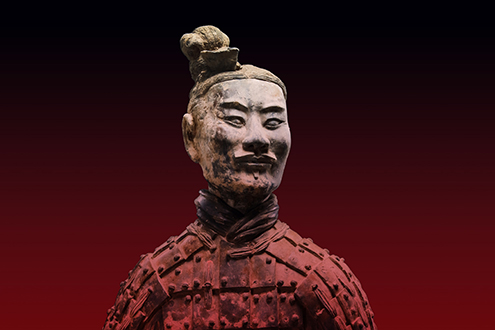‘Age of Empires’ Makes the Expansive Palatable

Courtesy of the Qin Shihuangdi Mausoleum Site Museum
“Kneeling Archer,” Earthenware of the Qin Dynasty, 201-206 B.C.. Artifacts from the Qin and Han Dynasties of China are on display at the Metropolitan Museum as part of its “Age of Empires” exhibition.
April 13, 2017
In a particularly strong season for the Metropolitan Museum, “Age of Empires” might be the cream of the crop. The exhibit chronicles the last 50 years of archeological work on art of China’s Qin and Han Dynasties, presenting ceramics, lamps, gold, statues and other artifacts for the first time in the United States. The result is stunning, informative and enthralling.
At the center of the show is a handful of the incredible terracotta warriors created for the first Qin emperor’s tomb. The hype surrounding these legendary works is completely justified — even in smaller numbers, they are imposing works. The soldiers are depicted in a perfect balance between looking identical and identifiable as individual figures. The exhibit explains that although they were mass-produced from the same six or so parts, detailing allows each to be unique among thousands.
The brief explanations behind each figure are fascinating as well, providing a glimpse into the extraordinary effort put into making the ceramic army. Seeing these incredible figures might be a once-in-a-lifetime chance, which is reason alone to check out this exhibit.
But that would do a disservice to the many other amazing works on display, all of which give life to the expansive and evolutionary history of China. These windows into daily life are fascinating. Artifacts include the likes of massive multi-layer candle lamps, ornate and intricate mirrors and a wine pourer in the shape of a perched bird. The eclectic collection of chachkies is one of the most extensive seen at the Met in quite some time, giving a fascinating — if brief — look into the many social and political aspects of two major dynasties.
Perhaps the most enthralling part of the gallery is its sense of globalization. The exhibit heavily emphasizes that China saw its greatest expansion under these two dynasties, when trade became a vital part of life. Further, they coexisted with the Greco-Roman empire — an important bit of historical context often lost in history classes. Seeing the ways in which the art and life of China interacted with other empires is a reminder of the ties that bind our entire planet.
Examples of this global sentiment include the statues of performers buried with Chinese emperors, believed to allow the emperors to partake in recreational joys during the afterlife. This phenomenon is strikingly similar to that of the Egyptians, who preferred burial with treasures and food set aside for the afterlife. Another incredible work is a statue of a Chinese strong-man — like those of contemporary circuses — that was said to be inspired by similar Greek works. And a giant model of a building has striking similarities to the clay architecture models of Latin America.
“Age of Empires” makes the dynasties not only feel massive in scope, but reminds us that the world is quite small, allowing for incredible confluences of culture and art. If you only go to the Met once in your NYU career, try to make this the time to go.
“Age of Empires: Chinese Art of the Qin and Han Dynasties (221 B.C. – A.D. 220)” is on view at the Met Fifth Avenue through July 16. Admission is pay as you wish.
Email Carter Glace at [email protected].























































































































































